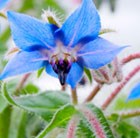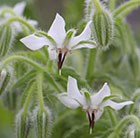Borage
by Diane - May 3rd, 2012.Filed under: allotment.
 There’s this plant on the allotment in the hedge that’s finally flowered. The flowers are blue. I think it’s borage.
There’s this plant on the allotment in the hedge that’s finally flowered. The flowers are blue. I think it’s borage.
Borage is a hardy annual.
You can use the pretty blue flowers in a salad or you can prserve them for topping cakes with. They are very pretty little blue stars.
Tea made from borage is supposed to reduce fever.
Also available in a white version from Crocus
borage (borage – organic) £1.99
Position: full sun or light shade Soil: fertile and moist Rate of growth: fast Hardiness: hardy annual (it will die within one year) A wonderfully useful as well as decorative plant. The young leaves and vivid blue flowers of this annual herb have a fresh cucumber-like flavour, so are often used in salads, soups, chilled drinks or simply as a garnish. The flowers attract bees and other beneficial insects, while the foliage has been known to reduce attacks of hornworm when planted between tomato plants. At the end of the year, add the plants to the compost heap as they will promote many beneficial minerals. Borage is an annual plant, but it will self-seed readily in good conditions. If you don’t want more plants, dead-head the flowers as soon as they fade. Garden care: Form shallow drills at 30cm intervals in a well prepared bed, and sow thinly, just covering the seed before watering well. The seeds have a higher germination rate when temperatures are between 15 – 25C, so early sowings can be covered with a cloche. When big enough to handle, thin the seedlings to 25cm. Sow: March – May Flowering: June – September Approximate quantity: 75 seeds.
white borage (white borage) £1.99
Position: full sun or light shade Soil: fertile and moist Rate of growth: fast Hardiness: fully hardy The white flowers of this borage make a fresh change to the more traditional blue. The bees will still flock to the nectar-rich blooms, and if picked, the petals can be used to decorate ice bowls and dress soups and salads. The young leaves of this annual have a cucumber-like flavour and can be added to many recipes. They are often used in pasta dishes, while the flowers can be used in ice cubes, salads and even dipped in batter and deep fried. Plant them between your tomatoes to reduce attacks of hornworm. At the end of the year, add the plants to the compost heap as they will promote many beneficial minerals. Borage is an annual plant, but it will self-seed readily in good conditions. If you don’t want more plants, dead-head the flowers as soon as they fade. Garden care: Form shallow drills at 30cm intervals in a well prepared bed, and sow thinly, just covering the seed before watering well. The seeds have a higher germination rate when temperatures are between 15 – 25C, so early sowings can be covered with a cloche. When big enough to handle, thin the seedlings to 25cm. Sow: March – May Flowering: June – September Approximate quantity: 75 seeds.








